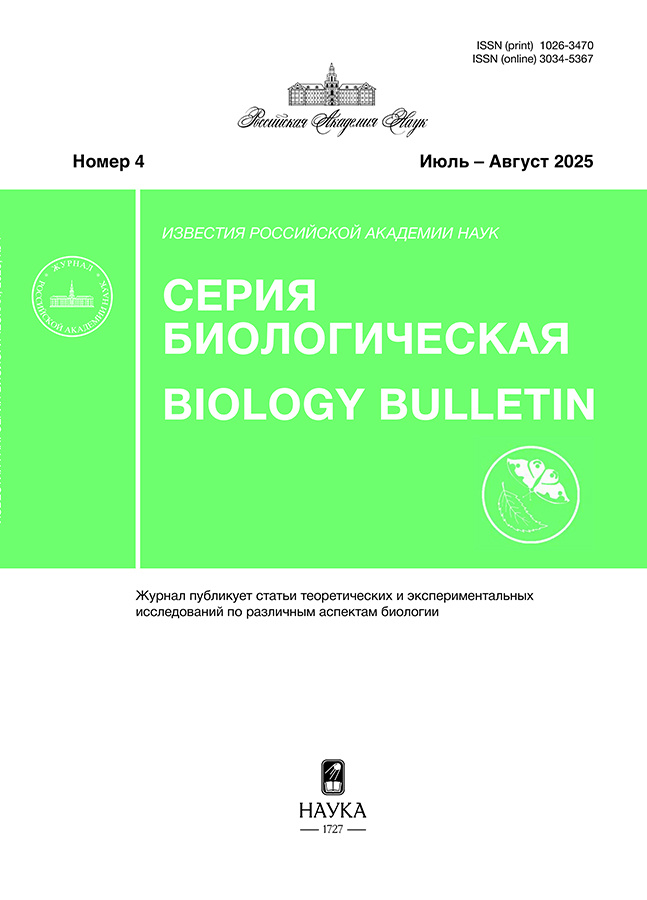A new approach to estimating speed of microorganisms uniform movement along a helical trajectory
- 作者: Lyakh A.M.1, Rauen T.V.1
-
隶属关系:
- Kovalevskii Institute of Biology of the Southern Seas, Russian Academy of Sciences
- 期: 编号 4 (2025)
- 页面: 489–494
- 栏目: КРАТКИЕ СООБЩЕНИЯ
- URL: https://rjmseer.com/1026-3470/article/view/687646
- DOI: https://doi.org/10.31857/S1026347025040128
- ID: 687646
如何引用文章
详细
Analysis of the motion of microscopic organisms is important for understanding their behavior, intrinsic state, and response to external conditions. Many free-swimming microorganisms move in three-dimensional space along a helical trajectory. When a three-dimensional trajectory is analyzed from video frames, it is transformed into a flat curve. This leads to loss of some of the motion data and, in particular, to errors in the estimates of the traveled path and true speed. We propose to estimate the length of a three-dimensional spiral path using the maximum length of the projection of the trajectory segment. The analysis showed that for rectilinear spiral trajectories, along which organisms move uniformly, this method in many cases allows us to correctly estimate the traveled path and true speed of movement, and to perform a correct comparison of the speeds of different microorganisms.
全文:
作者简介
A. Lyakh
Kovalevskii Institute of Biology of the Southern Seas, Russian Academy of Sciences
编辑信件的主要联系方式.
Email: me@antonlyakh.ru
俄罗斯联邦, Sevastopol, 299011
T. Rauen
Kovalevskii Institute of Biology of the Southern Seas, Russian Academy of Sciences
Email: antonlyakh@gmail.com
俄罗斯联邦, Sevastopol, 299011
参考
- Aragaki H., Ogoh K., Kondo Y., Aoki K. LIM Tracker: a software package for cell tracking and analysis with advanced interactivity // Sci. Rep. 2022. V. 12. 2702. https://doi.org/10.1038/s41598-022-06269-6
- Boakes D. E., Codling E. A., Thorn G. J., Steinke M. Analysis and modelling of swimming behaviour in Oxyrrhis marina // J. Plank. Res. 2011. V. 33. № 4. P. 641–649. https://doi.org/10.1093/plankt/fbq136
- Crenshaw H. C. A new look at locomotion in microorganisms: Rotating and translating // American Zoologist. 1996. V. 36. № 6. P. 608–618. https://doi.org/10.1093/icb/36.6.608
- Croze O. A., Martinez V. A., Jakuszeit T., Dell’Arciprete D., Poon W. C.K., Bees M. A. Helical and oscillatory microswimmer motility statistics from differential dynamic microscopy // New J. Phys. 2019. V. 21. 063012. https://doi.org/10.1088/1367-2630/ab241f
- Durante G., Roselli L., De Nunzio G., Piemomtese U., Marsella G., Basset A. Plankton Tracker: A novel integrated system to investigate the dynamic sinking behavior in phytoplankton // Ecological Informatic. 2020. V. 60. 101166. https://doi.org/10.1016/j.ecoinf.2020.101166
- Drescher K, Leptos K. C., Goldstein R. E. How to track protists in three dimensions // Rev. Sci. Instrum. 2009. V. 80. 014301. https://doi.org/10.1063/1.3053242
- Emami N., Sedaei Z., Ferdousi R. Computerized cell tracking: Current methods, tools and challenges // Visual Informatics. 2021. V. 5. № 1. P. 1–13. https://doi.org/10.1016/j.visinf.2020.11.003
- Ershov D., Phan M.-S., Pylvanainen J. W., Rigaud S. U., Le Blanc L., Charles-Orszag A., Conway J. R.W., Laine R. F., Roy N. H., Bonazzi D., Dumenil G., Jacquemet G., Tinevez J.-Y. TrackMate 7: integrating state-of-the-art segmentation algorithms into tracking pipelines // Nat. Methods. 2002. V. 19. P. 829–832. https://doi.org/10.1038/s41592-022-01507-1
- Fenchel T. How dinoflagellates swim // Protist. 2001. V. 152. № 4. P. 329–338. https://doi.org/10.1078/1434-4610-00071
- Gurarie E., Grunbawm D., Nishizaki M. T. Estimating 3D movements from 2D observations using a continuous model of helical swimming // Bull. Math. Biol. 2011. V. 73. P. 1358–1377. https://doi.org/10.1007/s11538-010-9575-7
- Rauen T. V., Mukhanov V. S., Baiandina I. S., Lyakh A. M. Influence of microplastics on the nutritional and locomotive activity of dinoflagellate Oxyrrhis marina under experimental conditions // Inland Water Biology. 2024. V. 17. № 2. P. 316–326. https://doi.org/10.1134/S1995082924020135
- Roberts E. C., Wootton E. C., Davidson K., Jeong H. J., Lowe C. D., Montagnes D. J.C. Feeding in the dinoflagellate Oxyrrhis marina: linking behaviour with mechanisms // J. Plankt. Res. 2011. V. 33. № 4. P. 603–614. https://doi.org/10.1093/PLANKT%2FFBQ118
- Vestergaard C. L., Pedersen J. N., Mortensen K. I., Flyvbjerg H. Estimation of motility parameters from trajectory data // Eur. Phys. J. Spec. Top. 2015. V. 224. P. 1151–1168. https://doi.org/10.1140/epjst/e2015-02452-5
- Yang Y., Qingxuan L, Yuezun L., Zhiqiang W., Junyu D. PhyTracker: an online tracker for phytoplankton // arXiv. 2024. arXiv:2407.00352.
补充文件












